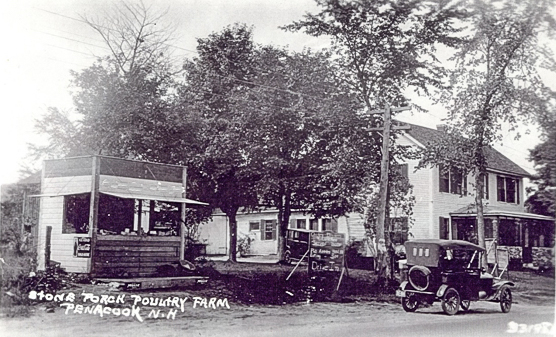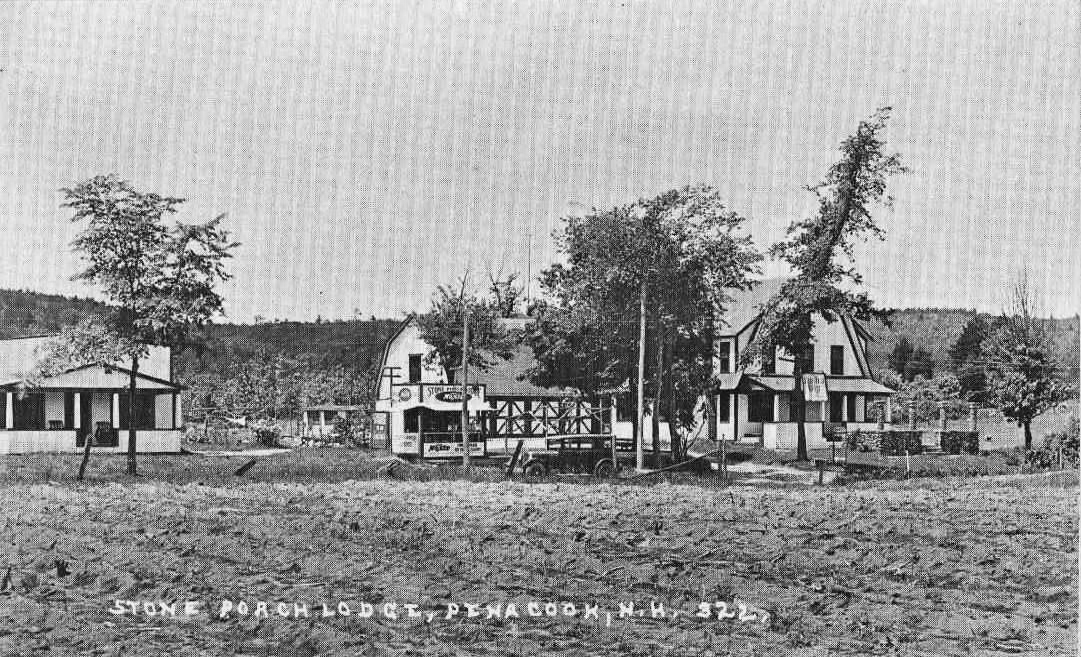by Elaine Clow
The Marshall family owned a large poultry farm, and with it a guest house called Stone Porch Lodge, where they took paying guests. They also ran fruit and vegetable markets and grew strawberries. Now they have pumpkins. Ken says:
“Walter Marshall moved to Center Strafford from Norwood, Massachusetts. They lived in a little cape with six acres of land, but Walter wanted to farm. Dr. Arthur Rowe of Penacook, Walter’s uncle, had purchased the property in 1917, after there was tragedy in the Dustin family during the Asian flu epidemic. There were six children in the family, and the mother and father died a year apart. Dr. Rowe adopted the girl, Muriel, and one of the boys also stayed with them. Two boys were farmed out to a family in Penacook, and two went to a family in Vermont.
Dr. Rowe settled the affairs of all six Dustin children, and purchased the Dustin property which he rented out for a while. He convinced Walther that if he wanted to farm, he better do it on the Dustin farm in Boscawen and not in isolated Center Strafford! So Walter sold his little cape on six acres of land in Center Strafford and purchased the Dustin property in Boscawen from his uncle, Dr. Rowe. This was in 1919.
Family history says that Walter and Bessie Marshall packed their dump wagon with all of their furniture and a crate of chickens on top, with a cow hitched to the back and a calf trailing and headed to Boscawen. They stayed overnight in some kind person’s barn on Rt. 129 and the next night were at home on the Dustin property. The three children then, were already at the uncle’s home in Penacook. Dr. Rowe was one of the first people in the area to own a car and he had brought them to Penacook earlier. Three more children, including Ken, were born in Boscawen.
Uncle Rowe took care of the family, purchased the property, and rented it out. Walter owned a cape in Center Strafford, and sold it to buy the property in 1919 from Dr. Rowe so he could farm. The family lore says that Walter packed all his worldly goods onto a wagon, along with a cow and calf and crate of chickens on top of the furniture. They trekked across route 129, and stayed in somebody’s barn overnight in Loudon and came on to Boscawen the next day. Three of the children were born in Center Strafford and three in Boscawen, (including Ken).
Walter got a job as a bookkeeper at the Freight railway station in Penacook, and farmed on the side. Walter was a bookkeeper for the B & M Railroad, and was never a telegrapher. The first roadside farm stand was built about 1920. Walter was a long-time Master of Halloween Grange in Penacook, and auditor for the Town of Boscawen with Alice Keneval for 36 years. He died in 1970.
Walter had fixed up a small chicken coop on the property to brood his first batch of baby chicks. Everything was ready. The oil-fired brooder stove was working and the baby chicks arrived by train. He brought them home and put them down in the coop under the stove hover. On May 3, 1926, a very windy day, the oil burner flooded, and a fire started. The upper bay doors of the barn were open and sparks ignited the hay. By that evening all that was left (besides shambles) was the Stone Porch on the end of the house next to the highway. Mr. Dustin had been a stone mason and constructed the porch. In later years one of the Dustin boys stopped by and asked for a piece of the stone porch, as he had lived and grown up there; after the fire there were two posts left behind.
Bessie Marshall had an older brother, Lenley Boultby, in Goshen, N.H., who was a carpenter and he came and reconstructed the house as it is seen today. The children were farmed out and Walter built a lean-to from scrap, salvaged a bed, and lived there until reconstruction was complete. A former Penacook fireman told Ken that he was at the fire that day, and it was so windy that the fire burned all the way to the Merrimack River.
From 1927 to the war years, the family took in summer boarders, at a charge of $10.00 per week per person, including meals for a couple, or $12.00 for singles. Bessie had wonderful help. The family raised chickens, both layers and broilers, as well as ran a hatchery that distributed chicks all over the state. The chicken business ran until 1963, along with the fruit and vegetable stand. Up to 10,000 chicks per week were distributed throughout the northeast, and they regularly attended poultry shows. In 1949 the Marshall hatchery had the honor of receiving the “Best Baby Chick” award.
During the war years Walter had a contract to produce chicken and eggs for the war effort, through Purina poultry feeds. At the time they had 6,000 hens and incubators to hatch the fertile eggs; they had incubators in the cellar, and also in the barn. Ken’s brother, Sumner, was in charge of the hatchery, and did the work of two full-time men for the required labor. On January 10, 1944 there was another fire, this time in the house at the kitchen end. Several rooms fell into the cellar. Potatoes had been stored against the south foundation, and they had to be hand-picked over to sort out the soft and burned ones. There were several rooms in the cellar, one containing potatoes stored near the south foundation. They had to be hand-picked over to sort out the soft and burned ones.”
Ken remembers that he had just gotten a new woolen red and black plaid shirt for Christmas, and tried to rescue it, without success. Another of the uncle contractors did repairs to the house after the 1944 fire. This was one of many times when students were kept out of school to work in the fields or on the farm. Ken was selected as valedictorian for his eighth grade class, but he wasn’t sure that he would be able to give his speech as his father often kept him home to work.
Ken attended UNH after the war, often hitch-hiking back and forth on the weekends to work on the farm, and do the egg route in Concord. He graduated in 1951. He married, and lived in the upstairs apartment with his wife Kay, and eventually their four children. In 1953 Ken took over the poultry business, and ran it until 1963, as well as the farm stand.
In 1960 Ken established a second farm stand on the Plain that he ran during the summer until 1977. He had plots of land in Canterbury, where he often traveled with his tractor to work on his crops. This travel gave him a chance to work on his parts for various performances held during Old Home Day celebrations, where they had musical entertainment, drum & bugle competitions, plays (Often written by Winnifred Lethbridge from the County Farm), food and a dance after the play. During the winters he worked for Gould Hill Orchard, where he pruned apple trees and worked at the Apple House controlled atmosphere storage facility in Penacook, after his farm stands closed in the autumn.
In 1977 Ken went to work at New Hampshire Farm Bureau, and farmed pumpkins on the property on the west side of Route 3, leasing the property on the east side to John Hugron of Canterbury. Today the pumpkin operation is run by Ken’s grandson, Josh; and Ken operates their Home Garden to provide for area food banks, and does all the harrowing and tractor work for the pumpkin operation.” (Interview with Ken Marshall, 2013)
CHICKENS
During the first half of the 20th century poultry farms thrived in New Hampshire, and indeed, in all northern New England, both for egg production and meat birds. Not only did Walter Marshall own Stone Porch Lodge, but J. Paul Jones was operating a large egg, poultry, and grain business at what is now the Crete Farm. Ralph and Ethel Sweatt had an operation on King Street, as did Richard Sweatt on Long Street. Charlie French on Water Street, I.E. Coulson on Route 3, and the Knowlton Family on Knowlton Road/ Corn Hill Road/ Water Street all had large poultry operations.

